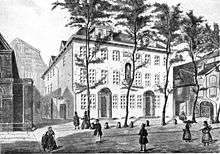Ludwig Erdwin Seyler
| Ludwig Erdwin Seyler | |
|---|---|
 | |
| Councillor (Senator) of Hamburg | |
|
In office 1813–1814 | |
| President of the Hamburg Commercial Deputation | |
|
In office May 1817 – July 1818 | |
| Preceded by | Jacob Albers |
| Succeeded by | Richard Parish |
| Member of the Hamburg Parliament | |
|
In office 1814–1818 | |
| Personal details | |
| Born |
15 May 1758 Hamburg |
| Died |
26 October 1836 (aged 78) Hamburg |
| Nationality | Hamburg |
Ludwig Erdwin Seyler (15 May 1758 – 26 October 1836; also Ludewig and Edwin, known as Ludwig E. Seyler or L.E. Seyler) was a merchant, banker and politician of the sovereign city-state, and briefly French city, of Hamburg. He was by marriage a member of the Hanseatic Berenberg banking dynasty, and was a co-owner of the Hamburg firm Joh. Berenberg, Gossler & Co. (Berenberg Bank) for 48 years (1788–1836) and the company's head for 46 years (1790–1836). Seyler was one of the first merchants and bankers from modern Germany to establish trade relations with the United States and East Asia. He served as President of the Commercial Deputation, one of the city-state's main political bodies, as a Councillor (Senator) and as a member of the Hamburg Parliament. Ludwig Seyler was a son of the Swiss-born theatre director Abel Seyler and a son-in-law of the bankers Johann Hinrich Gossler and Elisabeth Berenberg.
Background and early life
Ludwig Seyler was born in Hamburg and was the younger son of the Swiss-born Hamburg banker turned theatre director Abel Seyler, co-owner of the bank Seyler & Tillemann, who later became "the leading patron of German theatre" in his lifetime and who founded the Seyler Theatre Company,[1] and Sophie Elisabeth Andreae (1730–1764), a daughter of the wealthy Hanover court pharmacist Leopold Andreae (1686–1730), owner of the Andreae & Co. pharmacy. On his father's side he was descended from many of Basel's leading patrician families, including Seyler, Burckhardt, Socin, Merian and Faesch. After his mother died in 1764, he and his two siblings grew up in Hanover with their uncle, the noted Enlightenment natural scientist J.G.R. Andreae. His father remarried in 1772 to Friederike Sophie Seyler, Germany's leading actress of the second half of the 18th century and the author of the opera Oberon, a major influence on the libretto of The Magic Flute. Ludwig Seyler was a brother of the court pharmacist and Illuminati member Abel Seyler the Younger and of Sophie Seyler (1762–1833), who was married to the Sturm und Drang poet Johann Anton Leisewitz, the author of Julius of Tarent. His nephew Georg Seyler was the adoptive father of Felix Hoppe-Seyler, the principal founder of biochemistry and molecular biology.
Berenberg Bank

He joined the Berenberg company as an apprentice in 1775, aged 17.[2] On 20 May 1788, he married Anna Henriette Gossler (1771–1836), the eldest daughter of the company's owners, Johann Hinrich Gossler (1738–90) and Elisabeth Berenberg (1749–1822), and a member of one of Hamburg's most illustrious Hanseatic families, the Berenberg/Gosslers. His mother-in-law Elisabeth Berenberg was the only heir and last member of the Flemish-origined Berenberg banking family which had established the firm in 1590.
Shortly after his marriage, his father-in-law made him a co-owner of the Berenberg company. Upon the death of his father-in-law in 1790, he became the company's head, while his mother-in-law was a partner in her own right from 1790 to 1800. In 1798 his brother-in-law, the later senator Johann Heinrich Gossler, joined the company as a partner. Ludwig Seyler remained one of the two dominant partners until his death in 1836.[3][4]
During the 1806–1814 French occupation under Napoleon, he was one of a small number of prominent Hamburg citizens who were briefly taken hostage by the French in order to force the city-state to pay ransom to the French, which caused great consternation in the city-state. Berenberg Bank was for some time headquartered in his private home during the Napoleonic Wars.
Politics
As Hamburg was annexed into the Bouches-de-l'Elbe département of the First French Empire, he was appointed by the French as a deputy judge on the Commercial Court (tribunal de commerce). In 1813 he became a member of the Commercial Deputation, one of Hamburg's two, later again three main political bodies. On 9 June 1813 he was appointed as a member of the municipal council (conseil municipal), the governing body of Hamburg which had replaced the council (later known as the senate) under French rule. He served in the municipal council until it was dissolved on 26 May 1814 after the liberation of Hamburg. For a brief transition period, the former municipal councillors were asked to serve in the post-Napoleonic government. He then served ex officio as a member of the restored Hamburg Parliament in the then-independent city-state until 1818. He was President of the Commercial Deputation from May 1817 to July 1818.
Legacy
L.E. Seyler was highly regarded in Hamburg; he was described as "an honourable character, both as a merchant and as a human being."[5]
Issue and family
Ludwig Seyler and Anna Henriette Gossler had seven children, in order of birth
- Sophie Henriette Elisabeth ("Betty") Seyler (1789–1837), married to Hamburg businessman Gerhard von Hosstrup, who founded the Hamburger Börsenhalle in 1804
- Johann Hinrich Seyler
- Emilie ("Emmy") Seyler, married to the physician Ludwig Friedrich Christian Homann
- Louise Auguste Seyler, married to Gerhard von Hosstrup after the death of her sister
- Maria ("Molly") Seyler
- Louise ("Wischen") Seyler (1799–1849), married to ship broker Ernst Friedrich Pinckernelle (1787–1868), whose sons founded the G. & J. E. Pinckernelle insurance broker firm
- Henriette Seyler (1805–1875), married to the Norwegian industrialist Benjamin Wegner (1795–1864) of Fossum Manor, later of Frogner Manor[6]
His seven children were co-owners of Berenberg Bank from 26 October to 31 December 1836.[7]
Ludwig Erdwin Amsinck (1826–1897), a son of his niece Emilie Amsinck née Gossler and business magnate Johannes Amsinck, was named after him. Ludwig Seyler was an uncle of Hamburg head of state Hermann Gossler.
Portraits
There exist portraits of him and his two siblings as children.[8]
Gallery
 His father, the theatre director Abel Seyler
His father, the theatre director Abel Seyler His father's second wife, the actress Friederike Sophie Seyler, author of Oberon
His father's second wife, the actress Friederike Sophie Seyler, author of Oberon- His uncle and foster father, the natural scientist and polymath J.G.R. Andreae
 His brother-in-law, the poet Johann Anton Leisewitz, author of Julius of Tarent
His brother-in-law, the poet Johann Anton Leisewitz, author of Julius of Tarent His father-in-law Johann Hinrich Gossler, owner of Berenberg Bank
His father-in-law Johann Hinrich Gossler, owner of Berenberg Bank.jpeg) His daughter Henriette Seyler (1805–75, married Wegner) drawn by her sister Molly in 1822
His daughter Henriette Seyler (1805–75, married Wegner) drawn by her sister Molly in 1822
Ancestry
| Ancestors of Ludwig Erdwin Seyler | |||||||||||||||||||||||||||||||||||||||||||||||||||||||||||||||||||||||||||||||||||||||||||||||||||||||||||||||||||||||||||||||||||||||||||||||||||||||||||||||||||||||||||||||||||||||||||||||||||||||||||||||||||||||||||||||||||||||||||||||||||||||||||||||||||||||||||||||||||||||||||||||||||||||||||||||||||||||||||||||||||||||||||||||||||||||||||||||||||||||||||||||||||||||||||||||||||||||||||||||||||
|---|---|---|---|---|---|---|---|---|---|---|---|---|---|---|---|---|---|---|---|---|---|---|---|---|---|---|---|---|---|---|---|---|---|---|---|---|---|---|---|---|---|---|---|---|---|---|---|---|---|---|---|---|---|---|---|---|---|---|---|---|---|---|---|---|---|---|---|---|---|---|---|---|---|---|---|---|---|---|---|---|---|---|---|---|---|---|---|---|---|---|---|---|---|---|---|---|---|---|---|---|---|---|---|---|---|---|---|---|---|---|---|---|---|---|---|---|---|---|---|---|---|---|---|---|---|---|---|---|---|---|---|---|---|---|---|---|---|---|---|---|---|---|---|---|---|---|---|---|---|---|---|---|---|---|---|---|---|---|---|---|---|---|---|---|---|---|---|---|---|---|---|---|---|---|---|---|---|---|---|---|---|---|---|---|---|---|---|---|---|---|---|---|---|---|---|---|---|---|---|---|---|---|---|---|---|---|---|---|---|---|---|---|---|---|---|---|---|---|---|---|---|---|---|---|---|---|---|---|---|---|---|---|---|---|---|---|---|---|---|---|---|---|---|---|---|---|---|---|---|---|---|---|---|---|---|---|---|---|---|---|---|---|---|---|---|---|---|---|---|---|---|---|---|---|---|---|---|---|---|---|---|---|---|---|---|---|---|---|---|---|---|---|---|---|---|---|---|---|---|---|---|---|---|---|---|---|---|---|---|---|---|---|---|---|---|---|---|---|---|---|---|---|---|---|---|---|---|---|---|---|---|---|---|---|---|---|---|---|---|---|---|---|---|---|---|---|---|---|---|---|---|---|---|---|---|---|---|---|---|---|---|---|---|---|---|---|---|---|---|---|---|---|---|---|---|---|---|---|---|---|---|---|---|---|---|---|---|---|---|---|---|---|---|---|---|---|---|---|---|---|---|---|---|
| |||||||||||||||||||||||||||||||||||||||||||||||||||||||||||||||||||||||||||||||||||||||||||||||||||||||||||||||||||||||||||||||||||||||||||||||||||||||||||||||||||||||||||||||||||||||||||||||||||||||||||||||||||||||||||||||||||||||||||||||||||||||||||||||||||||||||||||||||||||||||||||||||||||||||||||||||||||||||||||||||||||||||||||||||||||||||||||||||||||||||||||||||||||||||||||||||||||||||||||||||||
See also
References
- ↑ Wilhelm Kosch, "Seyler, Abel", in Dictionary of German Biography, eds. Walther Killy and Rudolf Vierhaus, Vol. 9, Walter de Gruyter, 2005, ISBN 3110966298, p. 308
- ↑ Percy Ernst Schramm, Kaufleute zu Haus und über See, 1949
- ↑ http://www.berenberg.de/en/non-family-partners.html
- ↑ Tradition: Zeitschrift für Firmengeschichte und Unternehmerbiographie, Volumes 4-5, 1959
- ↑ Gallois, J. G. (1856). Geschichte der Stadt Hamburg: Spezielle Geschichte der Stadt seit 1814. 3. p. 497.
- ↑ Hamburger Nachrichten, 2 May 1824, p. 1
- ↑ Hamburger Nachrichten, 19 April 1837, p. 5
- ↑ Johann Anton Leisewitzens briefe an seine braut, vol. 1, p. xxvi, Gesellschaft der Bibliophilen, 1906
Literature
- Percy Ernst Schramm, Neun Generationen: Dreihundert Jahre deutscher Kulturgeschichte im Lichte der Schicksale einer Hamburger Bürgerfamilie (1648–1948), Vol. I, Göttingen, 1963
- Percy Ernst Schramm, Kaufleute zu Haus und über See. Hamburgische Zeugnisse des 17., 18. und 19. Jahrhunderts, Hamburg, Hoffmann und Campe, 1949
- Percy Ernst Schramm, "Kaufleute während Besatzung, Krieg und Belagerung (1806–1815) : der Hamburger Handel in der Franzosenzeit, dargestellt an Hand von Firmen- und Familienpapieren." Tradition: Zeitschrift für Firmengeschichte und Unternehmerbiographie, Vol. 4. Jahrg., No. 1. (Feb 1959), pp. 1–22. http://www.jstor.org/stable/40696638
- Percy Ernst Schramm, "Hamburger Kaufleute in der 2. Hälfte des 18. Jahrhunderts," in: Tradition. Zeitschrift für Firmengeschichte und Unternehmerbiographie 1957, No 4., pp. 307–332. http://www.jstor.org/stable/40696554
| Preceded by Jacob Albers |
President of the Commerz-Deputation May 1817–July 1818 |
Succeeded by Richard Parish |
| Preceded by Johann Hinrich Gossler (his father-in-law) |
Head of Berenberg Bank 1790–1836 |
Succeeded by Johann Heinrich Gossler (his brother-in-law) |
